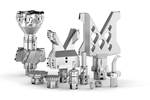6 Cutting Tools for Machining Made Via 3D Printing
By making tools, additive manufacturing aids so-called “subtractive” manufacturing (better known as machining). Here are examples of how 3D printing balances performance, coolant flow and weight in small and large cutting tools.
- A seemingly simple milling tool made via fused filament fabrication aids in the flow of coolant through the tool.
- Tools get larger, but with latticing and other possibilities of additive, they don’t have to get heavier.
- Here is what I believe to be the first topology optimized cutting tool we covered.
- Another followed. This larger and more complex topology optimized tool was inspired by the one above.
- The cutting tool maker producing the tools at the two preceding links also makes drills additively, but tools are not its biggest opportunity for AM.
- To make the hybrid AM cutting tools seen in the photo, the milling tool form is 3D printed onto steel shanks.
Related Content
-
Additive Manufacturing Is Subtractive, Too: How CNC Machining Integrates With AM (Includes Video)
For Keselowski Advanced Manufacturing, succeeding with laser powder bed fusion as a production process means developing a machine shop that is responsive to, and moves at the pacing of, metal 3D printing.
-
VulcanForms Is Forging a New Model for Large-Scale Production (and It's More Than 3D Printing)
The MIT spinout leverages proprietary high-power laser powder bed fusion alongside machining in the context of digitized, cost-effective and “maniacally focused” production.
-
Aircraft Engine MRO: How Additive Manufacturing Plus Robotic Finishing Will Expand Capacity for Blade Repair
AM offers the chance to bring fast, automated processing to individualized, part-by-part restoration of turbomachinery. A cell developed by Acme Manufacturing and Optomec is able to automatically repair 85,000 unique aircraft engine blades per year.













